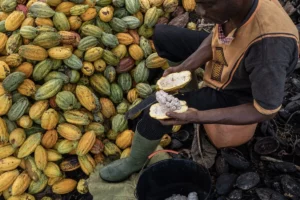Cocoa futures hit a historic peak in New York, signaling a sharp rise in chocolate costs.
This surge, the highest in 65 years, is driven by a significant drop in production from West Africa, the world’s leading cocoa supplier.
The adverse weather has spread diseases and hampered harvests, compounding the scarcity.
This price jump over the last year follows droughts and heavy rains in the region, disrupting the cocoa supply chain.
Such climatic challenges have led to delayed harvests and a surge in diseases, affecting crop yields.

Chocolate companies, including Hershey, face pressure as rising cocoa costs threaten to compress profit margins.
These escalating commodity prices come as manufacturers might soon exhaust their cocoa reserves, forcing them to absorb the recent price hikes.
Though some farmers are expanding their cocoa cultivation in response to higher prices, new crops will take years to mature.
Paul Davis from Sucres et Denrees and the European Cocoa Association predicts the tight market balance could last up to three years, with prices potentially reaching $6,000 per ton.
Cocoa Futures Surge to Record High
Thursday saw New York’s cocoa futures climb to $5,600 per ton, surpassing a 1977 record.
This rise in futures has led to increased costs for call options, indicating market anticipation of continuing high prices.
Despite this upturn, cocoa farmers have historically seen low returns, underscoring the need for better yields to justify investment in agricultural improvements.
At an Amsterdam conference, the Ghana Cocoa Board emphasized the importance of enhancing farm productivity for future stability.
Upcoming EU deforestation regulations could further escalate cocoa prices.
These new rules demand stringent data and traceability, posing an adjustment challenge for the market.
Consumers may face short-term price increases, but these measures aim to benefit the environment over the long haul, Davis explained.
This situation underscores the complex interplay between environmental policies, market dynamics, and global chocolate production.

